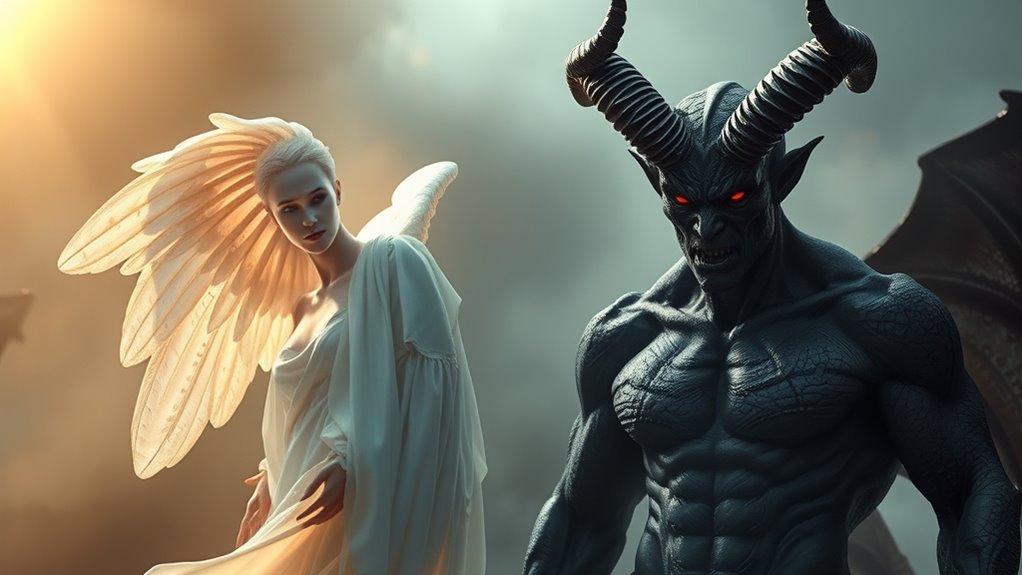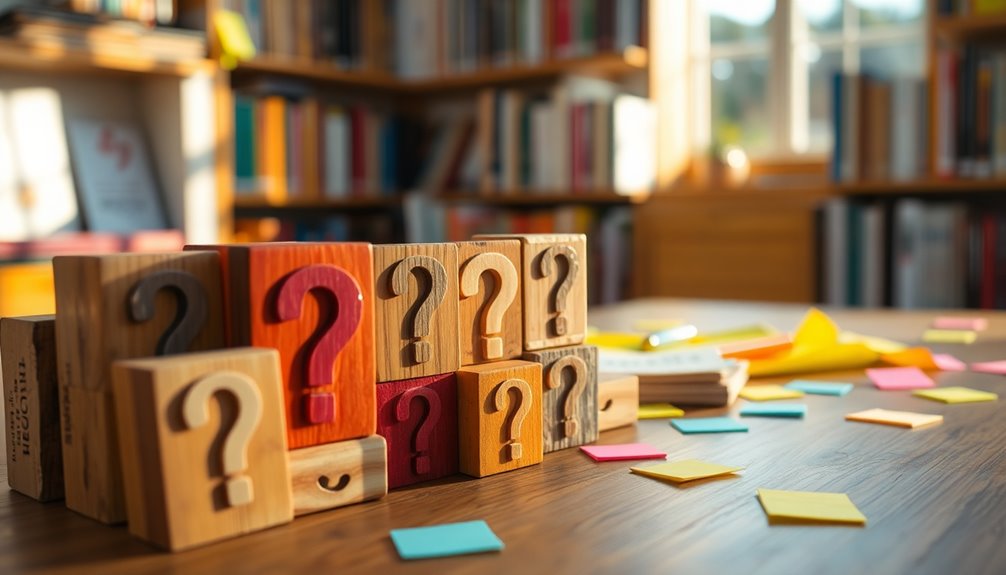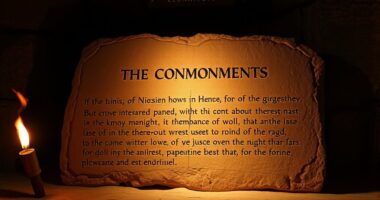Angels and demons are supernatural beings that symbolize the ongoing battle between good and evil in many religions and cultures. Angels are considered divine messengers and protectors, often represented with symbols of purity like halos and wings. Demons, on the other hand, embody malevolence, temptation, or chaos, with features like horns or claws. Understanding their roles, symbolism, and influence can reveal how these figures shape moral views and cultural stories—if you look further, you’ll discover even more about their fascinating significance.
Key Takeaways
- Angels are divine celestial beings serving as messengers and guardians in various religious traditions.
- Demons are malevolent spirits embodying evil, temptation, and chaos across many cultures and faiths.
- Both angels and demons are part of hierarchical spiritual structures, with angels often representing good and demons evil.
- They symbolize inner spiritual conflicts, moral choices, and the ongoing battle between good and evil.
- Visual symbols like halos and wings depict angels, while horns and claws are common for demons.
The Origins of Angelic Beings in Religious Texts
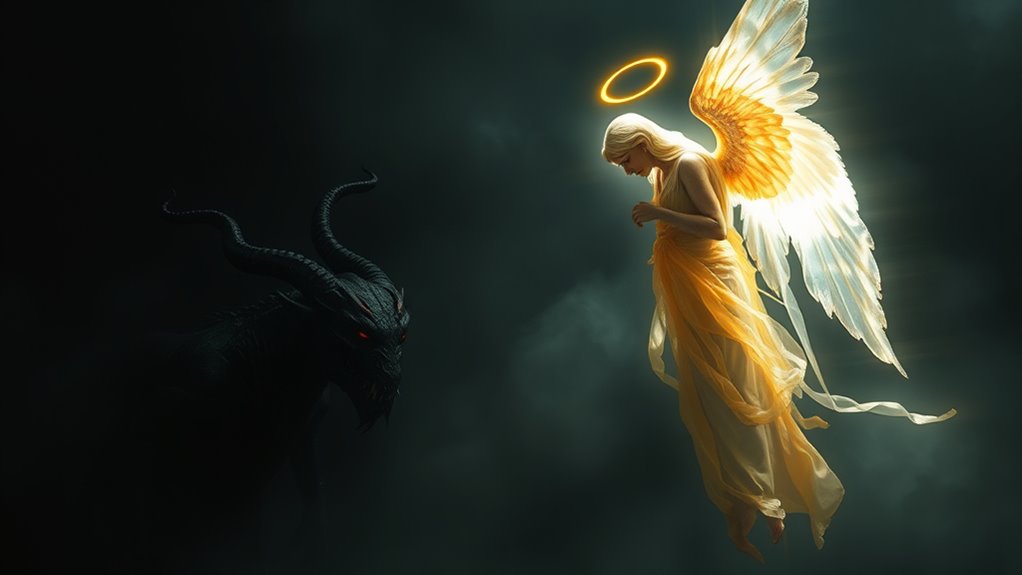
The origins of angelic beings in religious texts often trace back to ancient beliefs about divine messengers and celestial servants. Early traditions depict angels as messengers of God, carrying out divine will across the heavens. Over time, these beings became part of an angelic hierarchy, which categorizes them based on their roles and ranks. This hierarchy helps explain their functions and importance within spiritual spheres. Conversely, demonology classifications emerged to categorize malevolent spirits and fallen angels, contrasting with the pure beings of the angelic hierarchy. These classifications reflect humanity’s attempt to understand spiritual forces, dividing good and evil. Interestingly, some modern interpretations recognize that angelic hierarchy structures may have been influenced by cultural exchanges and evolving religious doctrines. Additionally, the development of demonology texts often served to delineate the boundaries between good and evil in various cultures. As you explore these origins, you’ll see how ancient beliefs shaped the complex structures of angels and demons present in religious texts today.
Different Types and Hierarchies of Angels
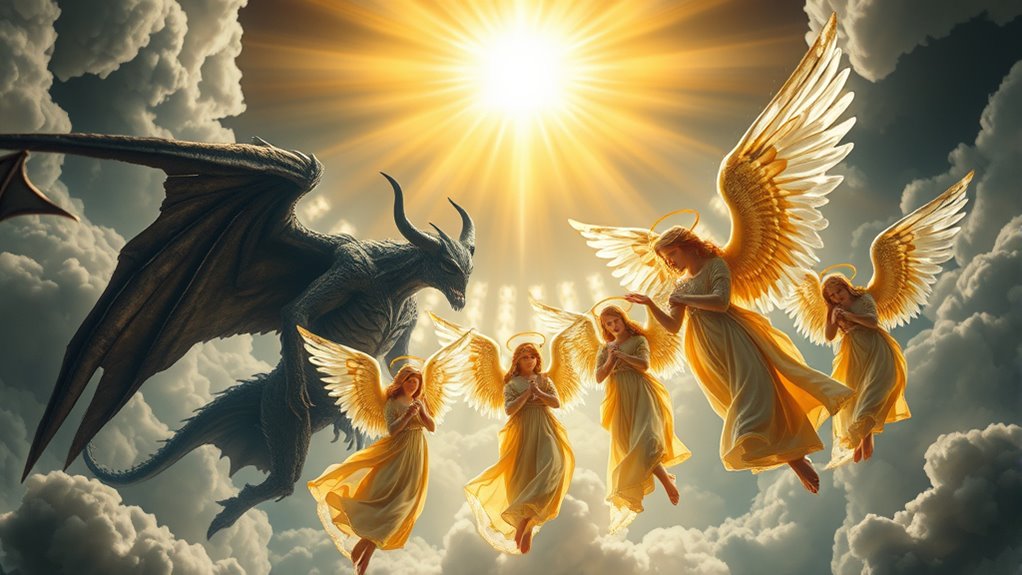
Building on the origins of angelic beings, religious texts and traditions often describe a complex hierarchy that categorizes angels based on their roles and levels of authority. This angelic hierarchy helps clarify their functions and ranks:
Religious texts depict a structured hierarchy of angels based on their roles and authority levels.
- Seraphim – The highest rank, known for their burning love and proximity to God. Their pure devotion underscores their special status within the celestial order.
- Cherubim – Guardians of divine knowledge and celestial objects. They are often depicted as symbols of divine wisdom and angelic hierarchy. Their role extends to safeguarding sacred mysteries and divine knowledge, emphasizing their importance in celestial governance. The different ranks are often associated with specific angelic roles, which further define their duties and significance.
- Archangels – Messengers and leaders, like Michael and Gabriel, who carry out important missions. Their roles frequently involve delivering crucial messages and guidance to humanity. Recognizing the hierarchical structure of angels provides deeper insight into their specific functions and significance in spiritual realms.
While the angelic hierarchy emphasizes order, there’s also a demonic classification that contrasts sharply with these divine ranks. Understanding these structures offers insight into how spiritual beings are organized across different traditions. Recognizing these signs of high spiritual energy can also deepen our understanding of angelic presence and their roles in guiding and protecting us.
The Concept of Demonic Entities in Various Cultures

Across cultures around the world, demonic entities are often seen as malevolent beings that embody chaos, temptation, or evil. Many believe these entities can influence or even take control of individuals through demonic possession, causing physical and mental suffering. In some traditions, demonic forces are viewed as antagonists opposing divine power, prompting stories of angelic intervention to banish or protect against them. These cultural beliefs shape rituals and exorcisms aimed at removing malevolent spirits and restoring harmony. The concept of demonic possession has been a central theme in many religious and cultural narratives, reflecting humanity’s ongoing conflict with perceived evil forces. Many societies also interpret these entities as spiritual threats, emphasizing the importance of spiritual protection and community rituals. Recognizing the cultural interpretations of demonic beings helps in understanding the varied ways societies confront and interpret these entities. Furthermore, understanding spiritual protection strategies offers insight into how communities cope with these fears. As beliefs about malevolent spirits vary widely, they often influence local practices and perceptions of evil. Across diverse societies, understanding these demonic entities reveals a universal fear of evil forces and the hope for divine protection against them.
Common Traits and Symbols Associated With Angels and Demons
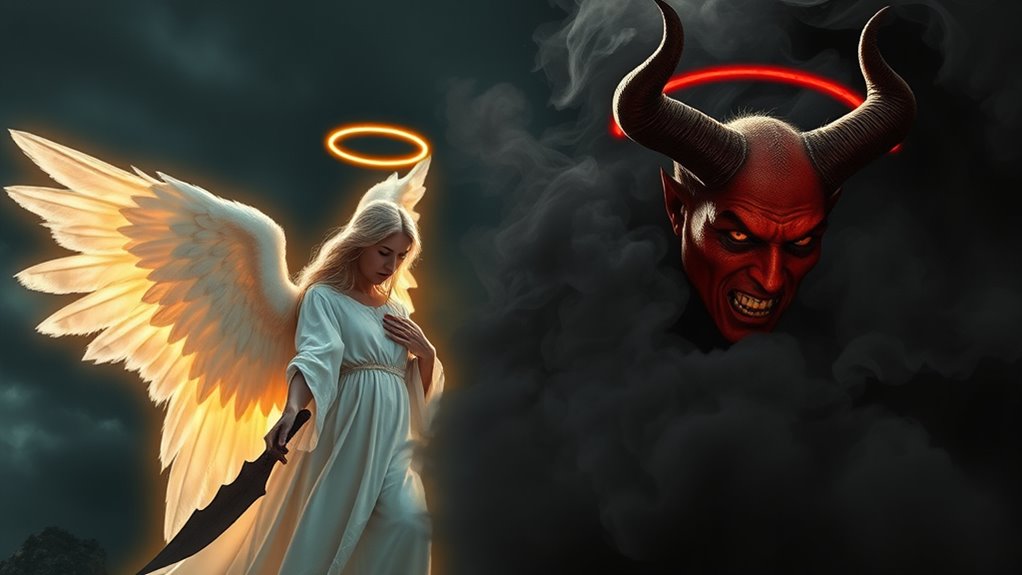
You’ll notice that angels and demons are often depicted with specific symbols and colors that convey their nature. Celestial hues like white and gold usually represent purity and goodness, while dark shades symbolize mystery or malevolence. Recognizing these emblems and gestures helps you understand the deeper meanings behind their representations. Additionally, Steampunk and Victoriana designs often incorporate intricate gears and mechanical motifs that reflect a Victorian-industrial aesthetic, which can also be found in some artistic interpretations of celestial and infernal beings. These artistic styles frequently emphasize symbolic imagery, enriching the visual storytelling behind these figures. The use of artistic symbolism further enhances the narrative qualities associated with angels and demons, connecting visual elements to their mythological roles. Moreover, the financial impact of entertainment industries influences how these beings are portrayed in popular culture, shaping our perceptions of their symbolism. Incorporating cultural symbolism from various traditions also adds layers of meaning to their depictions across different media.
Celestial Symbols and Colors
Celestial symbols and colors often serve as powerful identifiers for angels and demons, reflecting their nature and roles in various mythologies and religious traditions. These elements reveal deeper meanings through symbolic color meanings and celestial iconography. For example:
- White, representing purity and divine light, is commonly linked with angels, emphasizing their celestial purity.
- Black or red, often associated with demons, symbolize chaos, danger, or malevolence, highlighting their darker roles.
- Gold or radiant hues reflect divine authority and spiritual enlightenment, frequently seen in angelic imagery.
- The aura colors associated with these beings can also indicate their emotional and spiritual states, providing further insight into their roles and characteristics.
- Additionally, celestial symbolism such as stars or halos often emphasizes the divine or supernatural nature of these entities. The color symbolism used in their depictions helps convey their moral and spiritual alignment.
- These visual cues are not only artistic but also serve as cultural expressions, conveying complex spiritual concepts across different traditions and beliefs. Understanding spiritual symbolism enhances our appreciation of these representations.
These colors and symbols help you distinguish between celestial beings, offering visual cues to their symbolic roles. They serve as visual shorthand that encapsulates complex spiritual concepts, making celestial iconography instantly recognizable and meaningful.
Common Emblems and Gestures
Emblems and gestures serve as powerful identifiers for angels and demons, conveying their roles and nature through visual cues. For angels, symbols like open hands, wings, and halos represent angelic harmony and purity, emphasizing their peaceful and divine nature. They often use gestures that suggest blessing or protection, reinforcing their role as messengers of good. Demons, on the other hand, employ demonic symbolism such as horns, claws, or darkened eyes to evoke fear and chaos. Their gestures may include pointing or clenched fists, symbolizing aggression or dominance. These visual cues help us quickly distinguish between celestial and infernal beings, making their presence or influence more recognizable. Recognizing these emblems and gestures deepens your understanding of their symbolic significance in spiritual and cultural contexts. Additionally, understanding symbolic representations can enhance your perception of their influence in various stories and traditions.
The Roles of Angels and Demons in Spiritual Beliefs

You see angels as divine messengers carrying out God’s will, while demons are believed to oppose that purpose through influence and temptation. Fallen angels, in particular, are thought to sway humans toward darker paths, fueling spiritual conflicts. Understanding these roles helps you grasp how spiritual battles shape beliefs and moral choices. Additionally, the concept of spiritual conflicts underscores how these entities influence human morality and decision-making. Recognizing the distinction between these spiritual beings can deepen your understanding of moral dilemmas and the ongoing struggle between good and evil. The presence of fallen angels highlights the complex nature of these spiritual interactions and their impact on human behavior.
Divine Messengers’ Duties
Serving as divine messengers, angels and demons carry out distinct roles that influence spiritual beliefs around the world. Angels primarily facilitate angelic communication, delivering messages from the divine, guiding individuals, and offering protection. They act as intermediaries, helping you connect with higher powers and providing comfort in times of need. Demons, on the other hand, are often associated with negative influences like demonic possession, where they invade a person’s mind or body to sway their actions. Their duties may include testing faith or tempting individuals away from righteousness. Here are their key roles:
- Angels inspire hope through angelic communication and divine guidance.
- Demons challenge faith by inducing fear or possession.
- Both serve as symbols of spiritual conflict influencing beliefs worldwide.
Fallen Angels’ Influence
Fallen angels have long played a complex role in spiritual beliefs, representing the rebellion against divine authority and often embodying the darker aspects of spiritual conflict. They’re thought to influence human lives through subtle means, sometimes acting as misguided angelic guardians who have turned away from their divine purpose. These fallen entities are linked to demonic temptations, tempting you with shortcuts, vices, or destructive choices that lead you away from spiritual growth. Their influence isn’t always overt; instead, it often manifests as inner struggles or misleading allurements. Understanding this helps you recognize the ongoing battle between good and evil within your own life, as fallen angels symbolize the persistent presence of temptation and the importance of spiritual vigilance.
Spiritual Battle Dynamics
In many spiritual traditions, the ongoing battle between angels and demons embodies the struggle between good and evil that influences human lives. You can observe this dynamic through the angelic hierarchy, where different ranks of angels serve specific roles, and through demonic symbolism, which reveals the nature of evil forces. To understand this spiritual battle better, consider these aspects:
- The angelic hierarchy assigns roles from archangels to seraphim, highlighting their organized defense of divine order.
- Demonic symbolism often depicts demons as tempters or deceivers, representing chaos and moral corruption.
- This ongoing conflict influences human choices, with angels guiding toward righteousness and demons encouraging temptation.
Recognizing these roles helps you see how spiritual forces shape your moral landscape and daily struggles.
How Angels and Demons Influence Moral and Ethical Perspectives
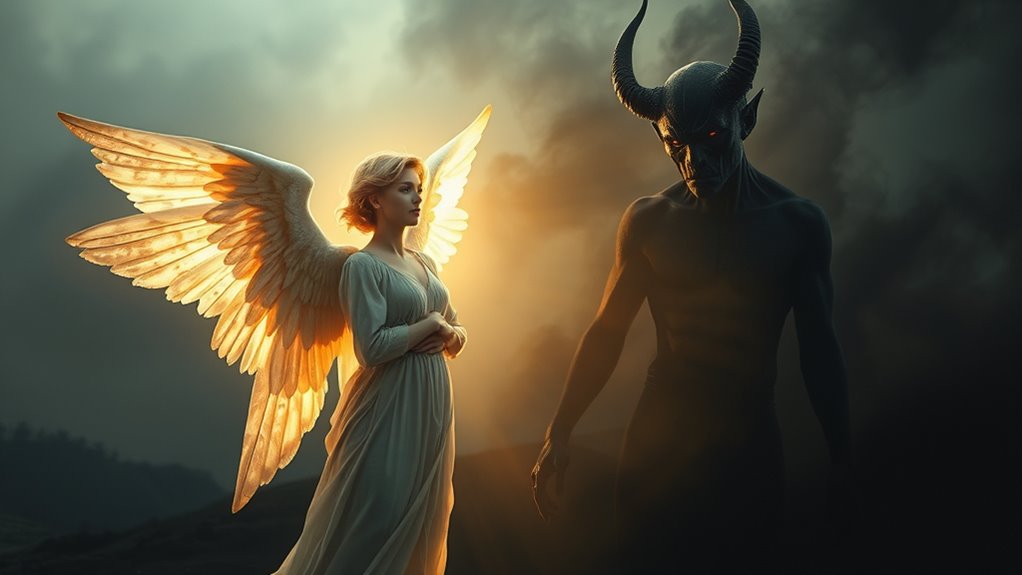
Have you ever wondered how the ideas of angels and demons shape your sense of right and wrong? They influence moral dilemmas and ethical decision making, guiding your perceptions of good and evil. These spiritual beings serve as symbols that challenge you to choose sides during difficult moments, often making you question your instincts. Their presence can evoke feelings of guilt or reassurance, depending on your choices. The table below shows how angels and demons impact your moral compass:
| Aspect | Angelic Influence | Demonic Influence |
|---|---|---|
| Moral Dilemmas | Encourages compassion | Tempts with selfishness |
| Ethical Decisions | Promotes honesty | Fosters deception |
| Inner Conflict | Brings peace or guilt | Sparks rebellion |
| Motivation | Inspires virtue | Provokes temptation |
| Outcome | Fosters moral growth | Risks moral decline |
Their roles shape your ongoing struggle with morality and ethics.
Depictions of Angels and Demons in Art and Literature
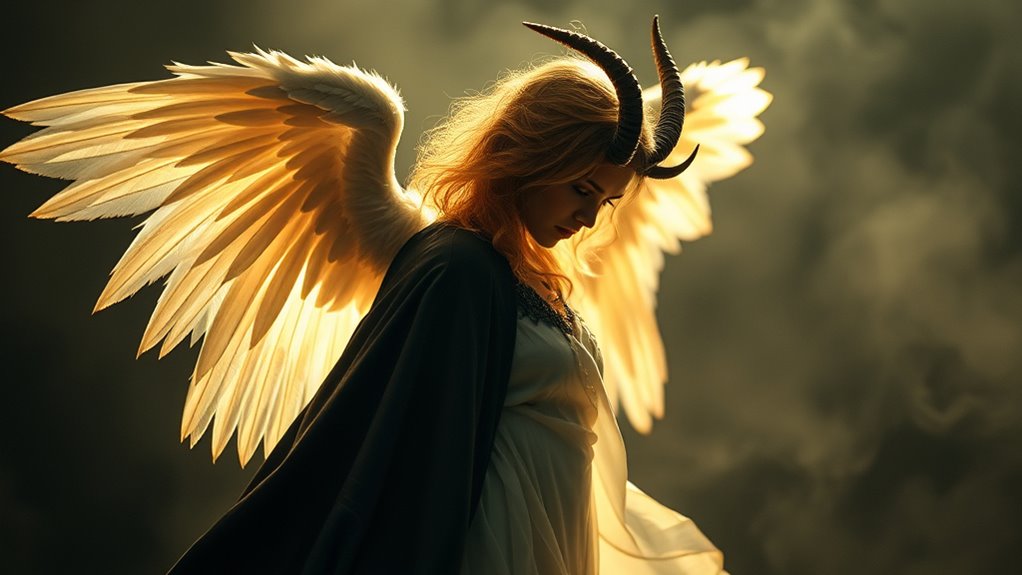
Throughout history, artists and writers have vividly brought to life the contrasting images of angels and demons, shaping how we perceive these spiritual beings. In medieval illuminated manuscripts, angels are often depicted with radiant wings, embodying purity and divine grace. Conversely, demons are illustrated with grotesque features and dark, twisted forms, emphasizing malevolence. Gothic iconography further intensifies these depictions, using stark contrasts and detailed symbolism to evoke emotional responses. Consider these examples:
Artists and writers have long contrasted angels’ purity with demons’ malevolence through vivid imagery.
- Illuminated manuscripts portraying angels with shimmering halos and serene expressions.
- Gothic art illustrating demons with snarling faces and chaotic, horned forms.
- Literary descriptions that contrast celestial harmony with infernal chaos, reinforcing their moral symbolism.
These visual and literary representations influence our understanding of their roles and significance.
Contemporary Interpretations and Significance of These Supernatural Figures
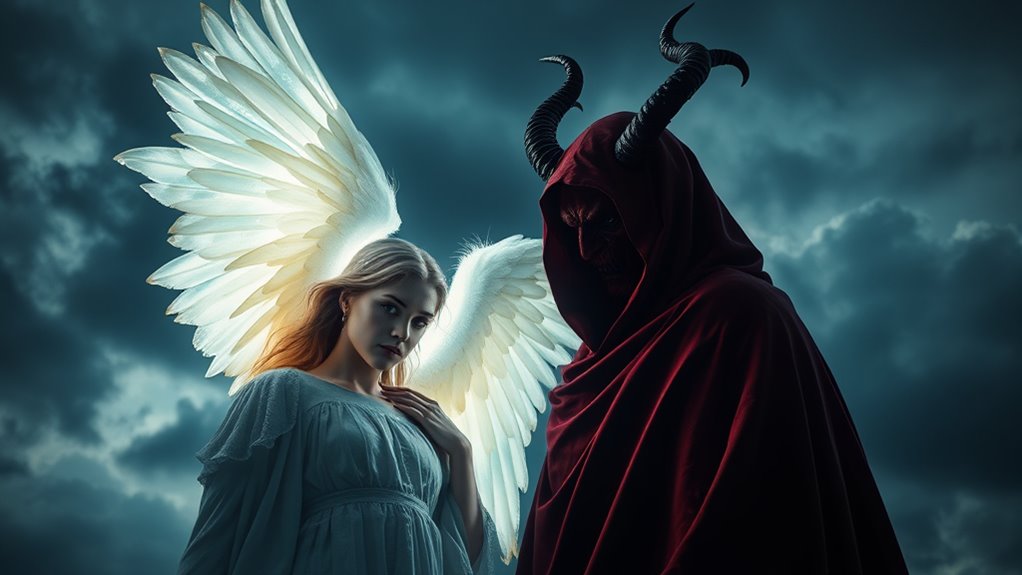
Contemporary interpretations of angels and demons often reflect evolving cultural values and personal beliefs, shaping how you understand these figures today. Many see angels through the lens of angelic music, which evokes feelings of comfort, hope, and divine connection. This musical aspect emphasizes their role as messengers of light and love. Conversely, demons are sometimes associated with demonic possession, highlighting fears of spiritual intrusion and loss of control. Modern narratives often explore these themes to symbolize inner struggles or moral conflicts. You might view angels as symbols of guidance and positivity, while demons represent the darker aspects of human nature. These interpretations help keep these supernatural figures relevant, resonating with contemporary issues and personal experiences.
Frequently Asked Questions
Are Angels and Demons Mentioned in Modern Science or Psychology?
You might wonder if angels and demons are part of modern science or psychology. Scientific skepticism generally dismisses them as supernatural, but psychological explanations often interpret reports of angels and demons as illusions or hallucinations influenced by stress, culture, or mental health. While science doesn’t support their literal existence, you can see these figures as symbols or manifestations of subconscious fears or desires, shaping personal experiences and beliefs.
How Do Different Religions Interpret the Existence of Angels and Demons?
Imagine the spiritual tapestry woven with angel symbolism and demon folklore, where each thread reflects a religion’s view. You’ll find that Christianity sees angels as messengers of divine love, while Islam views them as obedient servants. In Hinduism, celestial beings embody cosmic forces, and in folklore, demons often symbolize chaos or temptation. Different religions interpret these entities as symbols of good and evil, shaping moral stories and spiritual beliefs worldwide.
Can Angels and Demons Influence Human Free Will or Decisions?
You might wonder if angels and demons can influence your free will and moral decision making. While some believe they subtly sway your choices, many argue that your free will remains intact, and you’re responsible for your actions. Angels are seen as guiding you toward good, while demons tempt you toward temptation and vice. Ultimately, your ability to choose is yours, but spiritual influences can shape your moral path.
Are There Any Known Encounters or Experiences With Angels or Demons?
You might think encounters with angels or demons are mere stories, but many people report personal encounters or anecdotal experiences that challenge skepticism. Ironically, in a world driven by science, countless individuals swear by moments of divine intervention or sinister influence. These personal encounters can evoke awe, fear, or comfort, making it clear that whether real or imagined, they leave a profound mark on those who experience them.
How Do Cultural Differences Shape Perceptions of Angels and Demons?
You see, cultural differences deeply influence how you perceive angels and demons through cultural symbolism and mythological representations. In some societies, angels symbolize protection and goodness, while demons embody chaos or temptation. Other cultures might view these beings differently, shaping your understanding based on local stories, religious beliefs, and art. These varied interpretations reveal how cultural context molds your perceptions of these spiritual entities, making them unique across traditions.
Conclusion
As you explore the world of angels and demons, you realize how these figures subtly shape your morals and perceptions, often appearing when you least expect them—like a chance encounter or a fleeting thought. Their stories, symbols, and roles weave through history, art, and your own beliefs, reminding you that whether divine or dark, these supernatural beings reflect your ongoing search for meaning and understanding in life’s mysteries.

